Algebra basics: Video and teaching guide
Use this video as a springboard to introduce algebraic thinking, and to apply that thinking to a financial context, drawing on reasoning.
This video uses the scenario of friends and family saving money to support various charities. By changing the time available to save, the total amount to save and whether or not money has already been saved to be put towards the total, the friends work out how long or how much they need to save to reach their goals. We show how to develop and solve algebraic equations with pronumerals representing the unknown quantity.
Watch the video below with your students (full screen recommended).
Video duration: 3 min 57 sec
Suggestions to follow up video
Developing an equation to represent a real-life scenario
Objective: To understand how to use pronumerals to develop an algebraic linear equation to represent raising money and solve for an unknown.
In the video the friends want to raise money to support a charity. Their problem is knowing how long it will take to save the money. The unknown is defined and an algebraic equation is developed. Solving the equation for the unknown allows the friends to know how long it will take to reach their saving goal.
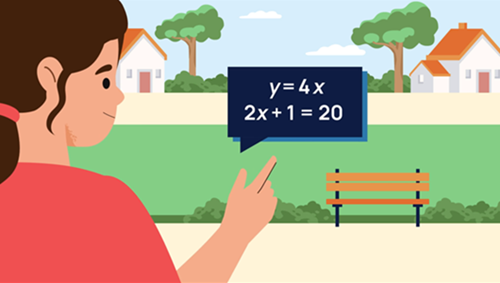
Role of teacher: Make explicit that a pronumeral is defined to represent an unknown number – it doesn’t matter which letter is used. For example, we could say that T = 4 × p where T is the total number of kilometres walked and p is the number of kilometres walked per day. The value of the total (T) varies depending on the value of p, or if I know the total needed, the number of kilometres to walk each day could be worked out.
Solve one-variable linear equations
Objective: To solve one-variable linear equations with counting numbers and verify the solution by substitution.
In this video a problem is presented about raising money for wildlife by getting sponsored for walking a total of 28 kilometres. The unknown quantity (How many kilometres they need to walk each day) is represented by a pronumeral ‘n’. The walk is completed over four days. Algebraically that can be written as 4n = 28.
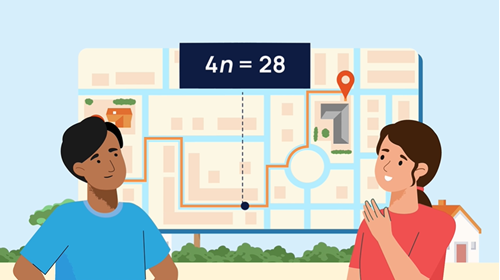
Ask students what is their estimate for 'n' that is definitely more than (lower bound) and definitely less than (upper bound). This will give them an idea if their calculated answer is reasonable. Without working anything out, students should realise that 'n' has to be more than 5 (which would be 4 x 5 = 20) and less than 10 (which would be 4 x 10 = 40).
The next problem involves donating money for injured wildlife. The unknown quantity (How many weeks is needed to save $48) is represented by a pronumeral ‘n’. The person saves $3 a week. Algebraically that can be written as 3n = 48.

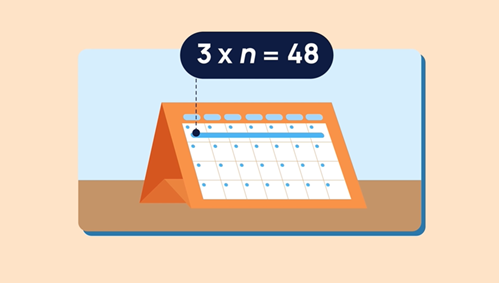
Ask students how they would solve the equation.
The challenge for students may be that the answer is larger than their known times tables (> 10). Students who are count all/additive thinkers may draw three circles and put dots in each circle until they have shared the 48.
A more complex equation
Objective: To formulate algebraic equations using constants (amount already saved), variables (number of weeks to save and amount to save each week) and operations. Create algebraic equations from word problems involving one or more operations.
In this problem Lucy has already saved $9. The unknown quantity (How many weeks is needed to save $48) is represented by a pronumeral ‘n’. We know Lucy saves $3 a week. Algebraically that can be written as 9 + 3n = 48.

Role of the teacher: the power of algebra is its ability to generalise for any variable (number of weeks, amount saved per week) and include an amount that has already been saved. If money has already been raised, do students expect this to reduce or increase the number of weeks needed to save the total amount of money?
How would students work out the unknown number of weeks, n, of saving needed?
An alternative method for students to solve this equation is to think of a number line. Wherever you place 3n, 9 + 3n will be to the right (greater than). This is equal to 48.
So 3n will be 9 less than 48.
The final step is to divide by 3.
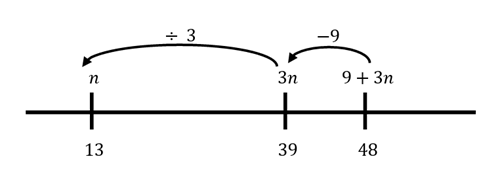
Alternatively, the equation can be built as follows (each set of vertical boxes are equal, for example, 3n + 9 = 48). The top row is built starting with , moving right until the equation is complete. Then the processes are reversed to determine the value of n.
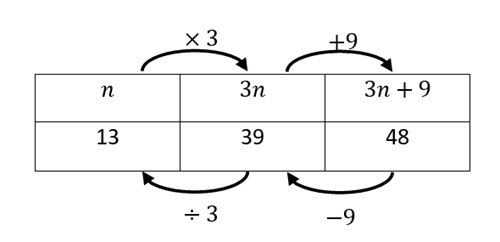
Ask students if it is possible to ÷ 3 first instead of −9? Prove that the result would be the same.
- Yes, it is. However, many students are often confused by the fractions produced (the numbers in this example are friendly and don’t result in fractions) or forget to divide all parts of the equation. In this case, the result would be 3 + n = 16, n = 13.
Reflection (Algebra basics)
Ask students to reflect on their investigations related to solving equations.
Reinforce that there are actually four parts (y, x, c, m), so you must know at least 3 to be able to solve the equation.
This is an introduction to a linear function: y = mx + c or y = a + bx
The total amount to be saved (y).
The amount saved per time period (m or b).
The number of time periods that you will save for (x).
The amount of money already saved (c or a).
Students can design their own savings scenario and have other students solve it.

A child and an equation, 9 + 3n = 48.
|

A child and two equations, 12 + 4n = 48, 12 + 4n = 100.
|